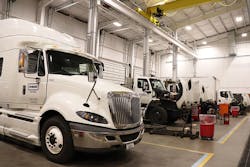This is the second of a three-part series on the changing aftermarket landscape and how to best source parts. Read Part 1 and Part 3.
Once you have the big questions figured out, you can start to focus on if you’re using the right combination of technology and people. You may even question your current sourcing relationship. But how do you know?
“You find out what good is after you’ve been treated bad,” answers Katie Scott, customer service manager in charge of fleet support at Summit Truck Group.
And in good relationships of any kind, communication is key.
“Poor communication is the downfall in any repair,” Scott said. “If there is not fluid conversation going on and questions being asked between the customer and the repairing dealer, it doesn’t matter how many things go right. It all goes wrong.”
Instead of accepting that a part is out of stock and downtime is inevitable, she stressed the fleet owner needs to call on the people they trust, as opposed to trusting the person saying the part isn’t available.
Scott recalled a time in the Northwest Plains where a truck leased through Summit broke down and was waiting for repairs at a non-International dealer. An exhaust pipe was rotted out, but no one had the part in stock.
Summit checked the pipe size and found one close enough in size that could be sent directly from Cummins the next day. A nearby shop completed the repair and a few hours later, the truck got back on the job.
“At the time of the call, it was down for two weeks,” Scott said. “If the owner had contacted me at the onset of the issue, he wouldn’t have sat for two weeks in Montana or Wyoming.”
Scott does balance human expertise with the unrivaled processing power of modern analytics. As an International dealer, they use OnCommand Connect (OCC), which uses telematics and sensor data to sense when a part may fail. As an assistive tool, it gives a parts support tech unrivaled supply chain visibility.
“I’m able to see the parts that work, what parts are available at different dealerships and then I’m recommending qualified dealerships with the part for the customer to schedule their downtime with,” Scott said.
On the OEM side, data derived from OCC helps Navistar predictively stock based on different locations and vocations.
“OCC allows us to be proactive instead of reactive and provides visibility for fleets they never had before,” said Kory, who said the data comes from 400,000 trucks, a third of which are International brands.
Rush Enterprises, the nation’s largest truck dealership, also has gotten into predictive technology with its e-commerce platform RushCare Parts Connect. Launched last spring, the site combines its network spanning 22 states with a sophisticated cross-referencing database tapping into its $220 million in inventory. Not only does the buyer get the right part, but they also get alternative choices, with prices listed to help them make the best decision for their business. And parts placed early enough can arrive the same day.
On top of that, the purchasing tool suggests other parts to complete the repair, such as a gasket or lubricants. The system also saves preferences to speed up future orders.
“We’re leveraging data married up with some artificial intelligence and machine learning to predict what customers need,” said Mike Eppes, managing vice president of parts at Rush Enterprises. “Amazon knows more about you than you know about yourself. The same thing applies here.”
The missing piece search
With complex puzzles, you hope everything fits neatly, but that’s not always the case. And sometimes pieces just come up missing. At the same time, suppliers are very aware that buyers’ expectations have changed in the last five or so years, permeating the trucking industry.
“There’s such an Amazon-esque fabric going on right now in general, where you’ve got people at home ordering things and getting them within a day or two, and then they take that personal experience with them to work and that’s their expectation now,” explained Christy Westrich, director of customer loyalty at Meritor. “Everybody expects to get things as soon as possible, and they’re measuring us to it now.”
This puts new pressure on manufacturers, suppliers and vendors to keep up with, or even exceed, the Amazons of the world.
To ensure they aren’t part of the parts problem, Meritor has launched its Uptime Services Group, a triage unit that focuses specifically on promptly supplying emergency or hard-to-procure components for fleets.
And while Meritor may be inspired by e-commerce trends, it relies more on humans than algorithms. Each customer is assigned an experienced representative to guide them through the repair process. Meritor’s internal goal is to reduce turnaround time, now at around a day, by 20%.
“The difference between a good experience and a bad experience is knowing that the person on the other end of the line with you has done everything in their possible power to get this done,” Westrich said.
Completing the puzzle
You may see some of these previous examples and think you are way behind. Not everyone has the same puzzle nor do they move at the same pace. Take time to evaluate your partners, see how well they communicate, and what questions they ask. You deserve the best, and that takes time. Just make sure you are being proactive. Parts may get shipped directly to you, but for the right solution, you’re going to have to get out and find it.
About the Author
John Hitch
Editor
John Hitch is the editor-in-chief of Fleet Maintenance, providing maintenance management and technicians with the the latest information on the tools and strategies to keep their fleets' commercial vehicles moving. He is based out of Cleveland, Ohio, and was previously senior editor for FleetOwner. He previously wrote about manufacturing and advanced technology for IndustryWeek and New Equipment Digest.



